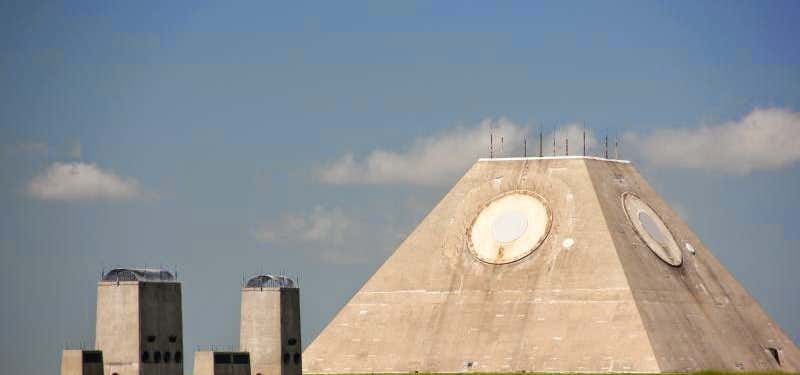“abandoned cold war missile complex”
A hundred miles away from Grand Forks, North Dakota lies a pretty bizarre cluster of buildings. From the outset it looks like a massive concrete pyramid, flanked by smaller structures. This is the Stanley R. Mickelsen Safeguard complex, and it was built for a singular purpose: To provide launch and control for 30 LIM-49 Spartan long-range anti-ballistic missiles and 70 short-range Sprint missiles, which were positioned in underground launch silos. It was operational for a mere 24 hours and cost $6 billion. It was named after former U.S. Army Air Defense commanding general, Stanley R. Mickelsen. What makes this building so badass is that it was built to withstand a nuclear bomb. The complex could detect range in upwards of several hundred miles and would guide the Spartan and Sprint missiles to intercept any attack. On April 1, 1975 the site was partially operational, and just a few months later it reached full operational capability, in October of that same year, and 24 hours after it became operational the House Appropriations Committee shut down the Safeguard program. In part, it was believed that should the Soviets launch a missile attack, the multiple warheads would "overwhelm the system." So, it was ultimately deemed to be ineffective. It was fully deactivated five months later. The site is now listed in the Historic American Engineering Record, a Heritage Documentation Program. The pyramid was 24-meters in height and is known as the Missile Site Radar (MSR), its purpose: To track warheads and guide interceptors. The four-sided pyramid was able to locate targets in every direction. The north-facing Perimeter Acquisition Radar (PAR) supported the MSR from 25 miles away, and was focused on Soviet missiles that were 800 miles away (i.e. once they passed over the North Pole), and the PAR was designed to "determine their trajectory and impact point." The complex was America's first operational anti-ballistic missile defense system. This was a pretty important building during the Cold War, in part because it helped convince the Soviets to agree to the Anti-Ballistic Missile Treaty. President Nixon's Safeguard Program was designed to "protect important strategic weapons assets," because of the fear of a Soviet-launched missile attack against America. These assets included the Minutemen ICBMs housed at Grand Forks Air Force Base. In fact, you can actually visit Minuteman Missile National Historic Site today. Many believe the Safeguard Program and the construction of the Stanley R. Mickelsen Safeguard Complex was an important component to the eventual decline of hostilities between the USSR and America. Read more: http://srmsc.org/
A must see site for any cold war buff. be aware it is privately owned so it can only be seen from outside the wire fence. A worth while stop would be to the Pain Reliever in Nekoma ND, just south of the site. A tavern. A man named "Bob" works there who was part of the crew that built the pyramid. very nice man and very informative about the site. This is an amazing part of America's history.
Eerily reminds me of the dollar bill..
According to the US Library of Congress webpage for this facility: - Significance: It is believed that the plans for deployment and initiation of construction of this facility were instrumental in obtaining Soviet agreement to the Anti-Ballistic Missile Treaty and a subsequent decline in Cold War hostilities between the Superpowers. This structure was nuclear hardened, that is, designed to withstand a nearby nuclear blast. Both the MSR with its data processing center and its power plant were nuclear hardened. The MSR was designed to be self-contained in case of attack. The MSR was a phased array radar, its beams were steered electronically instead of using heavy moving antennas. Rather than a large dish, this radar has thousands of small antenna built into each face. The MSR had a detection range of several hundred miles. It provided more precise, close-in target data than the PAR. The MSR was to ready interceptors (Spartan and Sprint missiles) for launch and then was to guide them to intercept. The MSR had four faces, allowing it to operate against attackers from any direction. A research and development version of the MSR had been built at the Kwajalein Missile Range (in the Marshall Islands). However, that version was not built partially underground like the MSR at SRMSC.
Another one (of many) of our government's waste of money!
Be the first to add a review to the Stanley R. Mickelsen Safeguard complex.
/-98.3565639,48.5894556,14/300x172@2x?access_token=pk.eyJ1Ijoicm9hZHRyaXBwZXJzIiwiYSI6ImNsczF1Y3RwcTA0ZmgycHAwbngweHlmbDAifQ.G6RP_RvWmMx8yNQSHb3PGQ)
Stanley R. Mickelsen Safeguard complex
Hours
Problem with this listing? Let us know.
Has RV parking changed? Let us know.
-
Parking
-
Pets Allowed
-
Restrooms
-
Wifi
-
Wheelchair Accessible
-
Credit Cards Accepted
Parking
Nearby Hotels
Related Trip Guides
The Great Northern is a 3,600 mile, cross-country odyssey
- 57 Places
- 69:15
- 3,565 mi
Road Trip Down US 83: The Road to Nowhere
- 36 Places
- 34:43
- 1,869 mi



